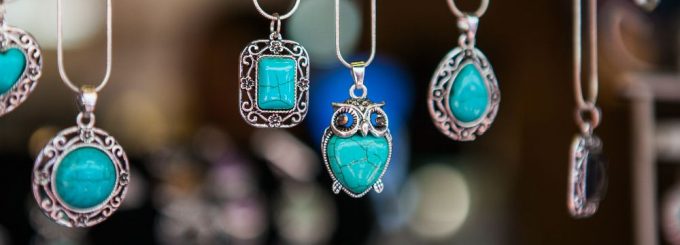Jewelry Spotlight: Raymond Gasper Zuni Sterling Silver Carved Buffalo Turquoise Multi Stone Pendant

The Zuni Amerindians are situated to the south of a Navajo Reservation in New Mexico. The group has become renowned for their fabulous jewelry, which has been around since 1880. This pendant by noted jeweler Raymond Gasper is a wonderful example of top-notch Zuni design. Find out more about the Raymond Gasper Zuni Sterling Carved Buffalo Turquoise multi-stone pendant in this post.
Origins
Originally, Zuni and Navajo jewelry were quite similar, but the introduction of lapidary work and turquoise eventually culminated in a distinct design. Since the 1920s, Zuni jewelry has been further divided into Inlay, Petit Point and Needlepoint jewelry. With the Needlepoint, individual stones will be cut into a needle eye shape then subsequently designed with intricate stone clusters to fashion the jewel.
Petit Point Jewelry on the other hand involves cutting stones into numerous shapes such as rectangles, ovals, squares, pears and rounds then setting them into sterling silver pieces. Inlay Jewelry also utilizes sterling silver, but with this method the jewels are crafted with channels for gluing precut and uniquely shaped stones. These stones will usually be sanded, polished and ground so that they can fit individual inlayed pieces.
Aside from pendants, Zuni jewelry might appear in other forms, such as earrings. These tend to be multicolored and are cut and made using mosaic patterns then set inside sterling silver bezel settings. The Kokopelli may be laminated or cut then subsequently laminated a second time on other forms of jet. This results in earrings which are highly dimensional. For buckle sets, the piece might be inlayed with yellow shell, turquoise or coral. They also tend to be multicolored and the pieces are sought after for their super lapidary crafting.
Inlay
While multiple Native American tribes design turquoise jewelry, including the Hopi, Navajo and Kewa, it is the Zunis who are most famous for their inlay. This is a special form of stonework where the stones are crafted and fit together, often sideways or using silver channels between them, which are called a channel inlay. Unlike other jewelers, the Zuni don’t cast their silver. Instead, every piece is fabricated carefully, and the most popular stones and colors used are red coral, mother or pearl, black jet and turquoise. The white/black stones symbolize duality, and they might also incorporate stones like abalone or ivory which has been fossilized. Due to the wide availability of materials now available, the Zuni no longer have to rely exclusively on materials that are located in their geographical region.
Highlights
This lovely pendant by Raymond Gasper incorporates classic Zuni design elements. It features sterling silver with turquoise and multiple stones. Its turquoise has been shaped into the image of a buffalo, which is a sacred animal to many Native Americans. It has been set within silver that features an outer bevel utilizing numerous distinct stones such as malachite, mother of pearl and coral. It was previously owned and as such manifests light wear along the sterling, and minor toning can be seen in other areas. Its turquoise stone has a few natural inclusions that are visible on its surface. This pendant is handmade and one of a kind.


